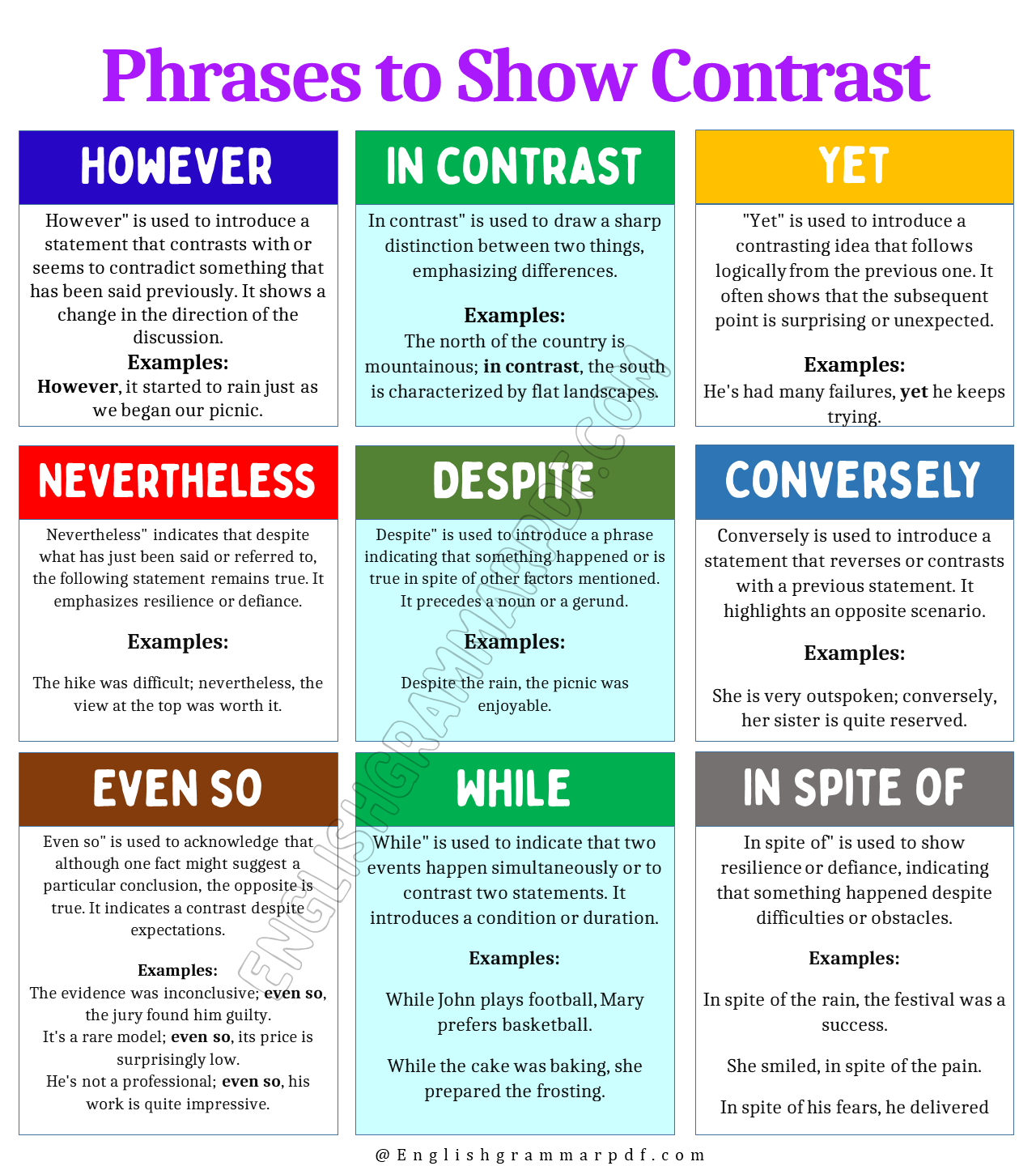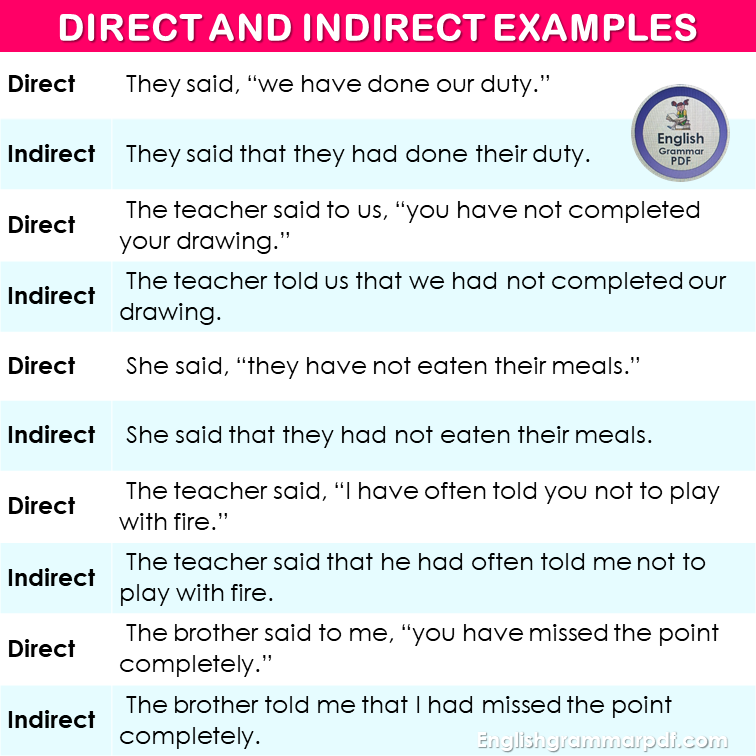In the art of communication, contrast plays a pivotal role, allowing us to draw clear distinctions and enrich our dialogues or writings. Whether you’re crafting an argument, telling a story, or simply explaining a complex concept, the ability to effectively highlight differences between ideas can significantly enhance your message’s clarity and impact.
This blog post delves into 20 versatile phrases used to show contrast. Understanding and using these phrases correctly can transform your writing, making it more engaging and persuasive. Let’s explore each phrase in detail, starting with its definition and followed by practical examples to help you master the art of contrast in your daily communications.
What are Phrases to Show Contrast?
Phrases to show contrast are linguistic tools used to express opposition between ideas, clarify differing points, or introduce alternative viewpoints. These phrases help structure arguments or narratives by signaling a shift in thought or highlighting differences that might not be immediately obvious. Using contrast effectively can make your writing more dynamic and your arguments more compelling, providing a clearer picture of the relationships between varying elements or ideas.
Phrases to Show Contrast
Here’s a list of 20 phrases that can be used to show contrast in your writing or speech:
- However,
- On the other hand,
- In contrast,
- Yet,
- Nevertheless,
- Although,
- Despite,
- Conversely,
- Even so,
- On the contrary,
- While,
- As opposed to,
- Unlike,
- But,
- Still,
- Whereas,
- Instead,
- In spite of,
- Contrary to,
- Alternatively,
Phrases That Show Contrast With Definitions
1. However
“However” is used to introduce a statement that contrasts with or seems to contradict something that has been said previously. It shows a change in the direction of the discussion.
Examples:
- However, it started to rain just as we began our picnic.
- She had very little time for preparation; however, she managed to pass the exam.
- The movie was predicted to be a flop; however, it turned out to be a blockbuster.
- I want to buy the car; however, I don’t have enough money saved yet.
- He planned to travel last week; however, his plans were postponed due to the weather.
2. On the other hand
“On the other hand” is used to introduce an argument that contrasts with the one previously mentioned in a discussion, providing an alternative perspective.
Examples:
- I like the design of the phone; on the other hand, I’m not sure about its durability.
- He is very intelligent; on the other hand, his brother excels in sports.
- The car is fast; on the other hand, it consumes a lot of fuel.
- On one hand, the policy could help the economy; on the other hand, it might increase inequality.
- The software is user-friendly; on the other hand, it lacks some advanced features.
3. In contrast
“In contrast” is used to draw a sharp distinction between two things, emphasizing differences.
Examples:
- The north of the country is mountainous; in contrast, the south is characterized by flat landscapes.
- She loves comedy movies; in contrast, her friend prefers horror.
- The first product was successful; in contrast, the second one was a commercial failure.
- Summer months are hot and humid; in contrast, winters are mild and dry.
- This model is equipped with numerous features; in contrast, the previous model was quite basic.
4. Yet
“Yet” is used to introduce a contrasting idea that follows logically from the previous one. It often shows that the subsequent point is surprising or unexpected.
Examples:
- He’s had many failures, yet he keeps trying.
- The path was challenging, yet they reached the summit before noon.
- It was a small investment; yet, it yielded high returns.
- She felt unwell, yet she decided to attend the meeting.
- The task was daunting; yet, everyone was eager to start.
5. Nevertheless
“Nevertheless” indicates that despite what has just been said or referred to, the following statement remains true. It emphasizes resilience or defiance.
Examples:
- The hike was difficult; nevertheless, the view at the top was worth it.
- He was very tired; nevertheless, he completed the marathon.
- The odds were against them; nevertheless, they managed to win the game.
- It was raining heavily; nevertheless, the event continued as planned.
- She knew the risks; nevertheless, she invested in the startup.
6. Although
“Although” introduces a subordinate clause indicating a contrast with the main clause. It often starts sentences where the two clauses are of opposing nature.
Examples:
- Although it was raining, we decided to go hiking.
- He went out, although he was feeling unwell.
- Although the task was hard, she completed it on time.
- Although they were late, they didn’t miss the train.
- She accepted the job offer, although the salary was lower than expected.
7. Despite
“Despite” is used to introduce a phrase indicating that something happened or is true in spite of other factors mentioned. It precedes a noun or a gerund.
Examples:
- Despite the rain, the picnic was enjoyable.
- She succeeded, despite having very little support.
- Despite the pain, he finished the race.
- Despite their differences, they remained good friends.
- Despite being underfunded, the project was completed on time.
8. Conversely
“Conversely” is used to introduce a statement that reverses or contrasts with a previous statement. It highlights an opposite scenario.
Examples:
- The first approach is very effective; conversely, the second is outdated and inefficient.
- He prefers detailed plans; conversely, his partner likes spontaneous decisions.
- Some see it as a weakness; conversely, others see it as an opportunity.
- In summer, the room is too hot; conversely, in winter, it’s too cold.
- She is very outspoken; conversely, her sister is quite reserved.
9. Even so
“Even so” is used to acknowledge that although one fact might suggest a particular conclusion, the opposite is true. It indicates a contrast despite expectations.
Examples:
- The evidence was inconclusive; even so, the jury found him guilty.
- It’s a rare model; even so, its price is surprisingly low.
- He’s not a professional; even so, his work is quite impressive.
- The trip was expensive; even so, many people signed up.
- She was not the fastest; even so, she won the race through strategic planning.
10. On the contrary
“On the contrary” is used to correct a negative impression given by a previous statement by asserting the opposite is true.
Examples:
- Many think he’s unfriendly; on the contrary, he’s just shy.
- It’s not a problem; on the contrary, it’s an opportunity.
- He didn’t fail to impress; on the contrary, he exceeded expectations.
- She isn’t weak; on the contrary, she’s one of the strongest people I know.
- This isn’t an end; on the contrary, it’s a new beginning.
11. While
“While” is used to indicate that two events happen simultaneously or to contrast two statements. It introduces a condition or duration.
Examples:
- While John plays football, Mary prefers basketball.
- While the cake was baking, she prepared the frosting.
- He decided to go hiking, while his brother stayed home.
- While some prefer summer, others love the charm of winter.
- The company is expanding, while maintaining its original values.
12. As opposed to
“As opposed to” is used to contrast two different elements, emphasizing the difference between them.
Examples:
- She chose tea, as opposed to
- They focused on quality, as opposed to
- We’re taking a road trip, as opposed to
- He prefers classical music, as opposed to
- The solution requires software changes, as opposed to hardware upgrades.
13. Unlike
“Unlike” is used to emphasize the differences between two or more items or people.
Examples:
- Unlike his sister, he is very punctual.
- Unlike most birds, penguins cannot fly.
- She loves the cold, unlike her friends who prefer the warmth.
- Unlike the earlier model, this car is very fuel-efficient.
- He completed the project on time, unlike his colleagues.
14. But
“But” is a conjunction used to introduce a phrase or clause contrasting with what has been previously stated.
Examples:
- I would go out, but it’s raining.
- She is small, but she is incredibly strong.
- They wanted to buy the house, but they couldn’t get the loan.
- He tried to be polite, but his irritation was obvious.
- The path was short, but very steep.
15. Still
“Still” is used to indicate that a previous condition remains in effect, or a contrast exists despite expectations.
Examples:
- He has a lot to learn, still, he has made remarkable progress.
- It was a small gesture, still, it meant a lot to her.
- The job is challenging, still, she loves it.
- They were defeated, still, they celebrated their effort.
- She was exhausted, still, she continued to work.
16. Whereas
“Whereas” is used to draw a direct contrast or comparison between two facts.
Examples:
- He loves to travel, whereas his wife prefers to stay home.
- You like tea, whereas I prefer coffee.
- Small cars can be economical, whereas large vehicles often consume more fuel.
- She handles the finances, whereas he takes care of the household.
- The first proposal was simplistic, whereas the second was detailed and practical.
17. Instead
“Instead” is used to suggest a substitute or alternative to something previously considered.
Examples:
- He decided to write an email instead of calling.
- They went to the park instead of the cinema.
- Use olive oil instead of butter.
- She took a break instead of continuing to work.
- We had dessert first, instead of last.
18. In spite of
“In spite of” is used to show resilience or defiance, indicating that something happened despite difficulties or obstacles.
Examples:
- In spite of the rain, the festival was a success.
- She smiled, in spite of the pain.
- In spite of his fears, he delivered an excellent presentation.
- They thrived, in spite of economic downturns.
- In spite of being warned, he continued with his plan.
19. Contrary to
“Contrary to” introduces information that is surprising or unexpected in light of previous knowledge.
Examples:
- Contrary to popular belief, bats are not blind.
- She succeeded, contrary to everyone’s expectations.
- Contrary to his initial reluctance, he enjoyed the party.
- The results were positive, contrary to the initial hypothesis.
- Contrary to his outgoing persona, he enjoys quiet evenings at home.
20. Alternatively
“Alternatively” introduces an additional option or suggests a different course of action.
Examples:
- You can take the bus, or alternatively, you can walk.
- We can eat now or, alternatively, after the meeting.
- Use this software, or alternatively, try the app we discussed.
- You can pay by cash, alternatively, we accept credit cards.
- He suggested going to the cinema, alternatively, we could stay home and watch a movie.



